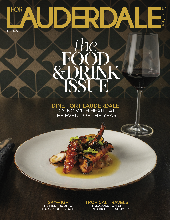When I came to this city over 40 years ago, it wasn’t long before I heard the moniker “Fort Liquordale.” For years I thought it referred to the crazy days of Summers on the Beach and the other wild clubs that sprouted up during the spring break days of yesteryear. That era ended as city fathers realized it was getting out of hand, and a reset came, aiming to attract families and the European tourist trade.
But actually, as some know, the tag “Liquordale” came from an era when there wasn’t supposed to be any liquor at all.
In 1920, the U.S. Congress — after years of lobbying by the committed do-gooders in the temperance movement, who thought drink was the root of all evils (especially crime) — passed a nationwide constitutional amendment prohibiting the production, importation, transportation and sale of alcoholic beverages.
Prohibition supporters, called “drys,” presented it as a battle for public morals. Opposition from the beer industry mobilized “wet” supporters, but they couldn’t halt the tide.
But in our city, which once was dry (as historian Stuart McIver tells us), drinking became suddenly fashionable. Women began joining in too, and in general people began drinking more heavily. Speakeasys popped up everywhere.
Up and down the coast it was the same. Even The Breakers in Palm Beach had a secret dining room where tourists could imbibe.
One historian said, “South Florida probably flouted Prohibition more than any other part of the country.”
It you had a problem finding booze, you could just go the police. Broward Sheriff Paul Bryan and his deputies were famously arrested in a rum raid along with Assistant Chief of Police Bert Croft.
How did all this happen? As the Wolf of Wall Street might put it: the market forces, baby! Supply and demand!
Just 60 miles away in the Bahamas, ruled by the British — who didn’t entertain such notions of mandatory sobriety — rum sold for $18 a case. Rumrunners smuggled it by sea to waiting entrepreneurs in coves on the New River and elsewhere, who sold it for twice that. In the North, a case could sell for a hundred bucks.
One of the legendary smuggling lanes came through Whiskey Creek, obscured in the natural vegetation of what is now Dr. Von D. Mizell-Eula Johnson State Park. It had the added advantage of being so shallow that the larger Coast Guard vessels couldn’t follow the smaller souped-up speedboats in.
Not that federal agents and the U.S. Coast Guard didn’t try to stop the trade. Off the coast of Fort Lauderdale an attempt by officers to arrest a smuggler named Horace Alderman ended up with two dead at the smuggler’s hands. He was tried and executed on the beach, our city’s first public execution.
Similar fatal shootouts lit up the Miami River. With South Florida flush with booze, it was natural for the country’s most notorious criminals like Meyer Lansky and Al Capone to take up residence.
Prohibition in South Florida, as a Miami Herald writer noted, “ushered in 13 years of illegal drinking, gambling, prostitution, rum running, high-seas machine-gun battles, public corruption and general scorn for the law. For all the notoriety of the mobbed-up ’50s, the cocaine-cowboy ’80s, even the hopped-up club scene of today, it was the most protracted and pervasive period of lawlessness and debauchery this region has known.”
The biggest irony of all was that in the years preceding the national directive, votes showed that Miami voters favored being “wet,” whereas voters in Fort Lauderdale and Dania chose “dry.” At the time, all the cities from Dania up to Deerfield Beach were part of Dade County.
Dade leaders had resisted efforts by Fort Lauderdale, Hollywood and others to form a new county. Realizing they could keep Miami wet by peeling off dry voters in Fort Lauderdale and surrounding towns, Miami officials finally decided to allow them to secede from Dade. A new county, Broward, was born in 1915.
Irony of ironies, that new county — spearheaded by Fort Liquordale — ended up as wet as they came.
Prohibition was formally repealed with a new constitutional amendment in 1933. There had to be a few dazed senators and representatives sitting around, saying, “Well, that didn’t work.”










